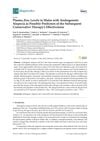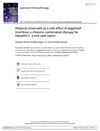Search
forLearn
2 / 2 resultslearn Osteopontin
signaling protein that, when suppressed, may grow hair by reducing inflammation and stem cell loss
Research
5 / 1000+ results
research Plasma Zinc Levels in Males with Androgenetic Alopecia as Possible Predictors of Conservative Therapy Effectiveness
Lower zinc levels may predict less effective hair loss treatment.
research Evaluation of the Effectiveness of Personalized Treatment of Trace Element and Vitamin Status in Men with Initial Stages of Androgenic Alopecia Treated with Conservative Therapy
Personalized vitamin and trace element treatment improves hair density and reduces hair loss in men with early-stage androgenic alopecia.

research Androgenetic Alopecia: May Growth Factor Mimetic Oligopeptides Supplement Minoxidil and Finasteride Therapy?
Certain peptides, caffeine, taurine, and an iron complex may improve hair regrowth when used with minoxidil and finasteride for hair loss.

research Alopecia Universalis as a Side Effect of Pegylated Interferon α-Ribavirin Combination Therapy for Hepatitis C: A Rare Case Report
A man lost all his hair as a rare side effect after hepatitis C treatment.
research Optimization of Conservative Therapy Approaches for Benign Prostatic Hyperplasia with 5-Alpha Reductase Inhibitors: A Clinical and Morphological Study
5-alpha-reductase inhibitors can effectively treat benign prostatic hyperplasia.
Community Join
5 / 146 resultscommunity Halted my hair loss with topical liposomal finasteride 0.01%
The user halted hair loss using 0.01% topical liposomal finasteride daily, with no side effects or regrowth, and recently added 5% minoxidil and low-level laser therapy. They recommend this conservative approach for those hesitant about finasteride.
community Why do I see so many people here recommend microneedling?
The efficacy of microneedling for hair regrowth as either a stand-alone therapy or adjunct to Minoxidil, and whether Tretinoin is a safer and more effective option. Replies include personal accounts from users who have had success with microneedling in combination with minoxidil and peptide serums, as well as considerations of technique, depth, and potential scarring.
community Hair transplant, dutasteride and topical minoxidil. Back from the dead.
A 24-year-old shared their successful hair restoration journey, which included a hair transplant in Turkey, dutasteride, and topical minoxidil. They also started testosterone replacement therapy, which improved their quality of life and hair condition, and they now feel confident and satisfied with the results.
community Opinions on current hair loss stack and recommendations for HT?
A 24-year-old man is seeking advice on his current hair loss treatment, which includes 0.5mg Dutasteride daily, 2.5 mg oral Minoxidil daily, and daily low-level light laser therapy, as he's not seen improvement recently. He's also considering a hair transplant in South Korea at age 25 and is asking for opinions on this plan.
community 8 months on 5mg fin daily, 5% min twice daily, and hrt(mtf). Thought my hair was unrecoverable before but now I’m so happy.
A user named "LordGeek101" shared their positive experience with hair regrowth after using 5mg of finasteride daily, 5% minoxidil twice daily, and hormone replacement therapy (HRT) for 8 months. The user is transgender (MTF) and mentioned that the larger dose of finasteride was recommended by their doctor for better chances of hair revival.